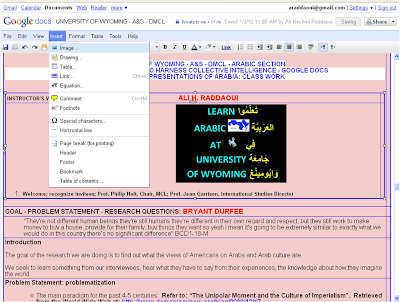
Compared to sending documents back and forth using email attachments, and receiving feedback or copies with edits on them effected by the senders, Google docs is a real-time collaboration tool. Here is how I have used it with my University of Wyoming students in one of the courses I have taught this year.
***
Firstly, you need a reason to use it. Very often, instructors ask students to write individual reports, papers or answers to an assignment. For the course I was teaching, the assignment was for students to write a paper on how Americans perceive Arabs. Much work was needed to get this paper ready, including conducing a decent literature review, agreeing on the methodology, learning enough about the ethics involved in data collection and the protection of subjects, and so on. In the end, we agreed to prepare a jointly-authored document and make a public presentation of our work. Each of the six students enrolled in the course chose to take care of one section of the presentation, to make that part readily available for viewing and enrichment by all other students. Google docs was the perfect host. Students were encouraged to work on the joint document both in the classroom and at home. Most of the work took place in the classroom though, and we agreed that there was no place for an inflated ego. Anything that appeared on the document was subject to scrutiny and editing by all. The merit of Google Docs is that it keeps a history of its own development, and so, if we wanted to revert to an earlier version of the document, we could.
***
What have we learned from this exercise? Well, a number of things: (i) Collective authorship is exciting and rewarding. The document quickly starts to take shape and grow in size; each student works on their section while some went a step further and made changes on their classmates’ sections. (ii) The existence of one central document that all participants can work on together simply means that all heads are put together. (iii) Instead of the regular ‘students write for the teacher’ paradigm, now students are writing with and for each other with the teacher facilitating, overseeing and also participating. (iv) Student collective work can be made visible to others that class may wish to invite, and (v) No time is wasted on access, and everyone is on the same page, (vi) Though the work is collective, there is no loss of student individuality; (vii) Students see, first hand, that together, they can create and author content. Because this content is collectively vetted, it has some claim to representing their collective if provisional, truths, understandings, and representations of reality.
***
Two comments are in order on the downside: (i) as usual, some students are more vigorously committed than others. This is a plus for those with potential for organizing and leading, but some may hide behind this collective action, and (ii) while all six students were all busy writing and editing the in-cloud document, it was often the case that clicking on the save button results in the loss of some data that is being inputted by a person other than the one who does the saving.
***
What has your experience been with Google Docs or other collective authorship tools? Have you used them strictly in academic contexts or also outside? What do you think is their potential for learning, teaching and joint content creation?
1 comment:
At first, I would like to thank you Pr. Ali H. Raddaoui for your new and revolutionary ideas which help people learn, communicate, and progress. After reading this post I am really impressed by the purspective of unifying the efforts of students to engender an original and affective work. I like the idea of urging people to progress and produce hand-in-hand following the same path yet with mixed ideas and concepts. Also, the fact of using GOOGLE DOCS is really tentative and attractive as a solution to provide an overt space where everyone can express his ideas in collaboration with others. Personally, I use this social software and I find it very beneficial and it facilitates working and interacting and it guarantees a high level of learning and education.
Post a Comment